Walden + Railroad + Sound
Michael Jarrett
01 I believe I understand what "imaging place" means or, rather, what it means to most of us most of the time. It is, more or less, a theory-lite designation for "setting." If that is correct, I cannot possibly imagine contributing anything valuable or original to a discussion of this topic. Why not? (I assure you. I am not declining to write the essay you are now holding.) My thinking can be quickly summarized. As a category of thought, "setting" arises with—it is an effect of—literacy. And setting or place represented in writing has been thoroughly theorized, beginning with Aristotle and continuing to present-day dissertations in composition-rhetoric departments. When it comes to the technology of writing or the apparatus of print, we in the humanities enjoy something akin to disciplinary consensus about effective ways to image or represent place with words. We have rhetoric. Barring the occasional internecine dispute, we generally subscribe to a commonly held set of methods for creating and ordering printed texts.
02 "It is a different story when it comes to teaching 'electracy,'" writes Gregory Ulmer, naming the episteme supplanting literacy. "How might information stored in databases be turned into knowledge on screens hyperlinked globally and designed with graphics?" (xii). There is no consensus here. Except for Ulmer's Internet Invention (2003), there has been no concerted attempt to theorize a rhetoric of digital media. Or more to the point of this essay and to a problem I want to address, if "setting" is a print-based concept, then what becomes of "imaging place" when media are digital? "Easy answer," some might say: "place becomes spectacle." Indeed, the society of the spectacle may very well end up being our shared reality. Perhaps, it is the reality we already inhabit, in which images and sound-bites undermine rational-analytical thinking (i.e., the legacy of literacy). But such a position, so compelling for its unrelenting negativity, ignores a possibility. We do not possess and practice a rhetoric for imaging place in a digital world because we have not yet invented it. Prognosticators of negativity provide us, then, with an imperative: if we do not invent electracy as a practice, we surely will practice what we shall inherit.
03 We might follow Ulmer's lead. He suggests that the best way to imagine electracy (the Internet as an apparatus that supports textual productivity) "is to invent a new practice of writing native to hypermedia" (xiii). That is, of course, a project of immense scale. I want to propose, instead, a task more manageable and modest. I believe that Thoreau's meditations on sound in Walden and, specifically, Thoreau's ideas about listening to the railroad provide us with a "relay" (or heuristic) for imaging place in electracy.
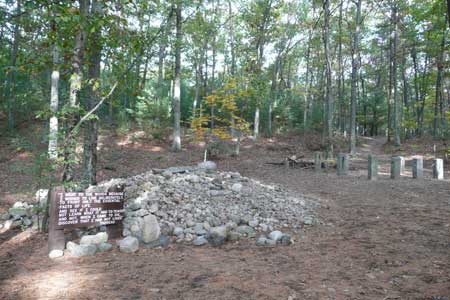
Site of Thoreau's one-room house on Walden Pond.
04 In due time, I will partially explain this belief. It is, to some extent, motivated by convention. Marc Weidenbaum reminds me that Walden Pond serves scholars of American literature much as the Galapagos Islands serve biologists. We go there for answers. More significantly, at least to would-be inventors of electracy, my turn to Walden is largely intuitive. I was led to it though the intellectual equivalent of sauntering, browsing, or taking a dérive. For me, "walden+railroad+sound" yields a string of words that one might use to initiate a Google search. I plug in the string, not because I am a Thoreau scholar (on the contrary, they intimidate me), but because I am following an impulse. It is more than a whim. I have a hunch.
05 But first, before getting to Walden, we need to make a long stop. Leo Marx begins his study of American literature, The Machine in the Garden, with an anecdote worth repeating: "On the morning of July 27, 1844, Nathaniel Hawthorne sat down in the woods near Concord, Massachusetts, to await (as he put it) 'such little events as may happen.'" In "minute detail" Hawthorne records "unadorned sense impressions," what he sees but, especially, what he hears. He notes sounds of nature—"birds, squirrels, insects, and moving leaves"—in concert with "sounds of labor": the village clock striking, a cowbell clanging, and "mowers whetting their scythes." As these sounds interlace, nature and society unify in the mind of the poet. "[W]e get," writes Marx, "an impression of a man in almost perfect repose" (11-13). Hawthorne evokes a pastoral ideal. There is harmony in this place.
06 So is your pastoral life whirled past and away," writes Thoreau (80). Very soon, this image of tranquility shatters. Hawthorne writes, "But, hark! there is the whistle of the locomotive—the long shriek, harsh, above all other harshness, for the space of a mile cannot mollify it into harmony" (qtd. in Marx, 13). Underwriting this unimaginable reconciliation between nature and machine is the Platonic notion (by way of Pythagoras) that harmony is the essence of music. Thoreau would have probably agreed. Twice, in 1838 and again in 1843, he copied the following passage from Sir Thomas Browne's Religio Medici:
For there is [a] music wherever there is a harmony, order, or proportion, and thus far we may maintain the music of the spheres; for those well-ordered motions, and regular paces, though they give no sound unto the ear, yet to the understanding they strike a note most full of harmony…. (qtd in Paul, 64)
Hawthorne hears the locomotive and the locomotive returns his gaze. For gaze does not have to be visual. The engine with its train of cars becomes a "field of attention" that evokes a mood (Ulmer 62). Following Heidegger, we observe that the Classical Greek attunement of "wonder"—founded on balance and proportion—has been banished, however temporarily, by a more modern attunement (Ulmer 59). The physical environment, but, more significantly, what John Kasson labels "the emotional texture of the world" has been altered irretrievably (188-89). Understand that, for Hawthorne, awe and fear have not mingled with joy. He does not experience an industrial-mechanical or technological version of what Kant called "the terrifying sublime," that emotion "which is 'accompanied by a certain dread or melancholy'" (qtd. in Kimmelman, 66). In short, Hawthorne has been shocked but not awed. "The trope of the interrupted idyll" conveys the particular and emergent modality of experience to which his emotional state is correlated (Marx 27; Ngai 5), and "emotions," as Sianne Ngai notes (citing Rei Terada), are "unusually knotted or condensed 'interpretations of predicaments'—that is, signs that not only render visible different registers of problem (formal, ideological, sociohistorical) but conjoin these problems in a distinctive manner" (3). A noncathartic feeling, then, gives rise to a noncathartic aesthetic that enables us "to examine problems whose greatest import arguably lies beyond the sphere of the aesthetic per se" (9, 2). "The Railroad," observed Emerson in his journal, "is that work of art which agitates & drives mad the whole people; as music, sculpture & picture have done on their great days respectively" (qtd. in Kasson, 179-80).
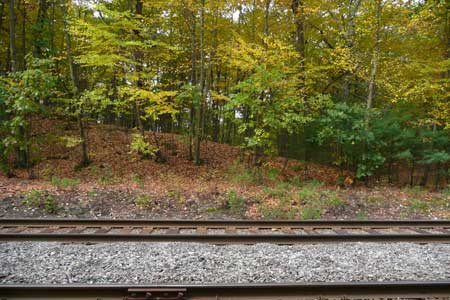
Woods near Concord.
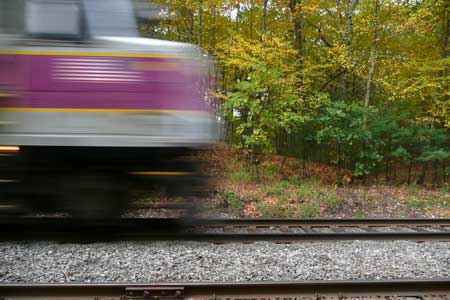
Railroad track beside Walden Pond
07 The "startling shriek" of the railroad, writes Hawthorne, "brings the noisy world into the midst of our slumberous peace" (qtd. in Marx, 13). The possessive pronoun "our" is important. To Heidegger, attunement is a cultural mood: the dominant key that sets the tone of being. It is historical and anything but private. Rather, it is "like an atmosphere"—by definition shared—"in which we first immerse ourselves in each case and which then attunes us through and through" (qtd. in Ulmer, 59). Hawthorne's mood, then, reveals a "being-together," a "belonging," an "intersubjectivity." Mood "is the effect of a merger of the outer and inner worlds," writes Ulmer. It suggests an alternative to theories of "correspondence" and "technological determinism" (59-60). To redirect Heidegger: The locomotive "must make itself felt, not as an inducing cause, but rather as that which attunes us." If the locomotive is startling, if it is fearsome,
then this thing outside the soul has in itself something of the possible, perhaps even suppressed attunement that is in us. Thus, although it is inside, the attunement plays around the thing outside at the same time…. It does not cause [fearsomeness], yet nor does it receive it merely as something attributed by the subject. In short: [fearsomeness]—and thus ultimately every attunement—is a hybrid, partly objective, partly subjective. (Heidegger, 1995: 88; qtd. in Ulmer 60)
Leo Marx concludes: What begins for Hawthorne "as a conventional tribute to the pleasures of withdrawal from the world—a simple pleasure fantasy—is transformed by the interruption of the machine into a far more complex state of mind" (15). As the train rolls on, Hawthorne's "idyllic vision" returns, albeit significantly altered. But as Marx notes, even in 1844, when the railroad was a "recent and in many ways revolutionary invention," Hawthorne's account was hardly original. It "doubtless belongs among the literary commonplaces of the age" (17). For example, that same year Wordsworth wrote "On the Projected Kendal and Windermere Railway," a sonnet protesting railroad expansion into the Lake District.
08 Lecturing in 1884 on Edouard Manet's painting "The Railway," Jacques de Biez said, "For future generations, our nineteenth century will be a locomotive, just as papal Rome is a tiara, as Venice is a gondola…and as our French Middle Ages is the armor of a baron" (qtd. in Dervaux, 1).
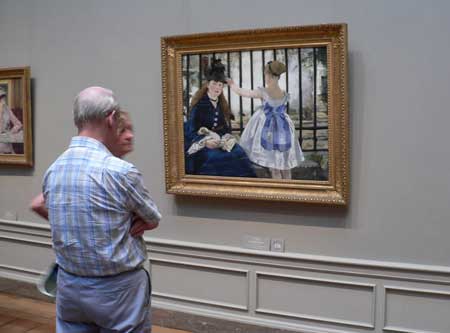
Edouard Manet, The Railway, 1872-1873 (National Gallery of Art).
09 Hawthorne may not have actually seen a locomotive any more than Manet painted one. Instead, both artists present us with images of a sonic icon capable of organizing information as mood. Synaesthesia? Perhaps. But entertain the possibility that synaesthesia was literally unremarkable in a world where senses were not radically differentiated. Hearing, as Jonathan Sterne demonstrates in The Audible Past, was separated from the other senses and constructed as a discrete activity during the 19th century (93).
10 Even if we have never read Hawthorne's account of reverie interrupted, we know some version of the machine-in-the-garden myth. Its value lies in its continued currency. We recognize this story of an old world swallowed by a new one. In Hawthorne's version of the myth, place becomes—it is devoured by—what Marc Augé calls non-place, though place "is never completely erased" and non-place is "never totally completed" (79). Hawthorne writes a distinctly modern myth of sound in which noise effaces place. "The noise of the train, as Hawthorne describes it, is a cause of alienation in the root sense of the word: it makes inaudible the pleasing sounds to which he had been attending, and so it estranges him from the immediate source of meaning and value" (Marx 27).
11 In "Divertissement on a Folk Theme," Claude Lévi-Strauss diagrams the myth of noise. He begins by posing a rhetorical question:
If one were to ask an ethnologist ex abrupto in what circumstances unrestricted noise is prescribed by custom, it is very likely that he would immediately quote two instances: the traditional charivari of Europe, and the din with which a considerable number of so-called primitive (and also civilized) societies salute, or used to salute, eclipses of the sun or the moon. (286)
What do these two culturally sanctioned manifestations of noise have in common and what do people hope to achieve by enacting them? Lévi-Strauss speculates and produces an answer that he will dismiss as too easy. The occasion that prompts the charivari (typically an old man marrying a young girl) pictures a sociological "monster" figuratively devouring an innocent body. The occasion that prompts noisemaking at an eclipse pictures a cosmological monster devouring the sun or moon (287). Hence, the charivari punishes a reprehensible union on earth and noise at an eclipse seeks to ward off a dangerous conjunction in the sky. Both rituals employ noise as a counter-discourse to drive off or to expel a parasite. Noise identifies and interrupts communication between bodies—terrestrial and celestial.
12 Is it not true, writes Lévi-Strauss, that not conjunction but disruption of an enduring order is the phenomenon common to these two events? On a cosmological level, the normal alternation of the sun and the moon, day and night, light and darkness, heat and cold has been interrupted. On a sociological level, the convention of men paired with women—"who are in a relation of mutual suitability in regard to civil status, age, wealth, etc."—has been broken (288). The din at a charivari or at an eclipse punishes "not just a simple conjunction…but something much more complex which consists, on the one hand, of the breaking of the syntagmatic sequence, and on the other, of the intrusion of a foreign element into this same sequence—an element that appropriates, or tries to appropriate, one term of the sequence, thus bringing about a distortion." The noise-making rituals draw attention to celestial and terrestrial noise, thus exposing "an anomaly in the unfolding of a syntagmatic sequence" (289). Noise at one level, then, is converted to noise at another level. When an old, wealthy widower marries a young woman, a charivari or shivaree transforms social noise—produced by the misalliance—into information (or noise), so that the system—in this case, a community—will not be disorganized. "In a certain sense," writes Michel Serres, "the next level functions as a rectifier, in particular, as a rectifier of noise. What was once an obstacle to all messages is reversed and added to the information" (Serres, qtd. in Paulson 48).
13 Reduced to formula, the Hawthorne account can be cast as a romantic response to classicism disrupted by modernism (i.e., modernism as an eruption of entropy or an explosion of information). In structuralist terms, the sound of the locomotive devours the place that gives birth (in a continuing sense) to classicism.

Locomotive behind the author's house. York County Heritage Trust's Agricultural and Industrial Museum.
14 More analytically, the locomotive decisively breaks a presumably natural—redundant or highly predictable—syntagm. In Lectures on the History of Literature, Ancient and Modern, Friedrich Schlegel writes:
Between the poet and nature, no less than between the poet and the man, there is a sympathy of feeling. Not only in the song of the Nightingale, or in the melodies to which all men listen, but even in the roar of the stream, and the rushing of the forest, the poet thinks that he hears a kindred voice of sorrow or of gladness; as if spirits and feelings like our own were calling to us from afar, or seeking to sympathize and communicate with us from the utmost nearness to which their natures will allow them to approach us. It is for the purpose of listening to these tones, and of holding mysterious converse with the soul of nature, that every great poet is a lover of solitude. (qtd. in Paul, 43)
Hawthorne journeys into the woods to find solitude and inspiration, first and foremost, as a vocational imperative. Poets have routinely heeded the call to retrace this line of flight. They do not go to a sacred place so much as they sacralize the places they go. They sustain the world, ensure continuity, by "holding mysterious converse with the soul of nature." While any man can sit in the midst of a sylvan glade and hear the songs of birds, the melodies of men, the roar of streams, and the rush of the forest, only the poet truly listens to these "tones." Through them, he communes with some metaphysics of presence (the Divine in one form or another). He harmonizes—vibrates sympathetically—with the music of the spheres. The implications of a failure to listen or to communicate, then, are terrible to contemplate, implying that something is wrong either with the world or with the poet. On the one hand, if something has happened to the world—for example, nature cannot mollify technology into harmony—then the poet has lost his employment (does he then become a prophet?). In disrupting Hawthorne's solitude, the locomotive breaks, not just the reveries of one poet, but a much larger syntagm: a line of poets communing with nature and the divine, stretching back to antiquity at least to Virgil. On the other hand, if the poet is unable to "sympathize" with nature, hear it as "a kindred voice of sorrow or of gladness," then he has missed or he has lost his calling. The noise of the locomotive, Hawthorne complains, in effect silences God. This is precisely the position that understands modernism as the atrophy of meaningful sound (harmony) and the hypertrophy of the visual, and it is precisely the position that Derrida inverts. He systematically demonstrates that "the elevation of speech as the center of subjectivity and the point of access into the Divine is 'essential to the history of the west, therefore to metaphysics in its entirety, even when it professes to be atheist'" (Sterne 17).
15 Derrida's deconstruction of Western metaphysics (and, in particular, of the sound/vision binary) may have contributed to a contemporary emphasis on vision over audition, no matter how often we refer to media as employing multiple senses. But that is unlikely. Jonathan Sterne offers another explanation. Much scholarship purports to offer us "an entry into the history of the senses" but, instead, posits what "happens between the senses." For example, in "outlining the differences between sight and hearing," some authors "refer back to physics; others refer back to transcendental phenomenology or even cognitive psychology." Their aims are remarkably singular: they "demarcate the purportedly special capacities of each sense as the starting point for historical analysis" (15- 16). They construct (or reinforce) what Sterne calls an "audiovisual litany." Thus, "the starting point for historical analysis" is posited as a series of transhistorical, quasi-theological constructs. And it is as if deconstruction never happened. Pedagogies that aspire to teach visual literacy, "because we live in a visually oriented world," fall into this category. They forget, as Sterne reminds us, that "before the senses are real, palpable, concrete, or available for contemplation, they are already affected and effected through the particular historical conditions that also give rise to the subject who possesses them" (5). Sterne is drawing on Karl Marx. The very same year, 1844, that Hawthorne sought solitude in woods near Concord, Marx wrote of the senses being "cultivated or brought into being." Our assumptions about basic and ineluctable differences between sight and hearing are, Marx declared, ideological. "'Man himself becomes the object' to be shaped and oriented through historical and social process" (Marx, qtd. in Sterne 5).
16 A concentration on historical and social process will help us avoid the analytical trap that pictures the railroad, more or less, materializing out of thin air and transforming everything in its path. "Impact narratives," writes Sterne, "cast technologies themselves as primary agents of historical change" (7). They deify technology, enabling claims such as, "The Internet is changing the way we write," or "the sound of trains changed the way people heard the world." Thoreau challenges impact narratives and the deification of technology in the "Sounds" chapter of Walden. He engages the concept of determinism by employing the image of railroad tracks.
When I meet the engine with its train of cars moving off with planetary motion,—or, rather, like a comet, for the beholder knows not if with that velocity and with that direction it will ever revisit this system…when I hear the iron horse make the hills echo with his snort like thunder, shaking the earth with his feet, and breathing fire and smoke from his nostrils, (what kind of winged horse or fiery dragon they will put into the new Mythology I don't know,) it seems as if the earth had got a race now worthy to inhabit it. If all were as it seems, and men made the elements their servants for noble ends! (75-76)
If only! Thoreau exclaims. "If all were as it seems." "What happens instead," writes Stanley Cavell, underscoring Thoreau's crucial point, "is that men will mythologize their forces, as they always have, project them into demigods, and then serve their projections." The cornerstone of the old mythology (Calvinism, in a word) was election. "[T]he new mythology will make the railroad engine (their technology, their inventions) their fate." It thus reveals "their inability to trust themselves to determine their lives; or rather, to their inability to see that they are determining them." "[W]e have determined," Cavell continues, "that we shall be governed by fate—by something that denies for us the incessant exercise of our control" (97). Thoreau declares: "We have constructed a fate, an Atropos, that never turns aside" (77).
The startings and arrivals of the cars are now the epochs in the village day. They go and come with such regularity and precision, and their whistle can be heard so far, that the farmers set their clocks by them, and thus one well conducted institution regulates a whole country." (77)
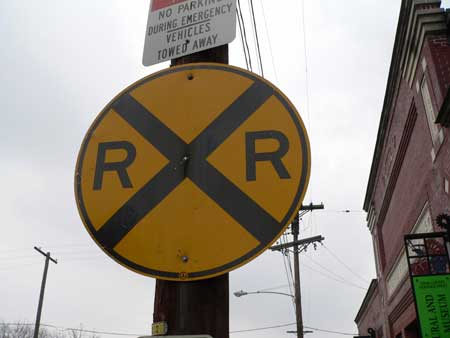
Railroad crossing behind the author's house.
17 We should be excused for getting lost in an image that Thoreau develops almost to the point of allegory. In short, he was no apologist for "technological deification." Thoreau does not write that we have in the railroad a machine that, like fate, never turns aside. Far from it. Rather, we have constructed a mythology of fate and fate has found its emblem in the railroad. "You only need sit still long enough in some attractive spot in the woods and the railroad will exhibit this to you," writes Thoreau (148). He sounds like Nietzsche. Both men viewed "life as a form of art, built upon willful deceptions and incorporating transient meanings. Thus the philosopher became a purveyor of metaphors." Both asked: "What pictures might make the world a more fulfilling place to pass through?" (Chamberlain 34, 36). Thoreau answers, extending and redirecting his railroad metaphor: "Every path but your own is the path of fate. Keep on your own track, then" (77). "The lesson," writes Cavell, "is that we can turn from fate by keeping steady, keeping still" (98).
18 But why direct contemporary readers to Walden's canonical passages on the railroad? To multiply sociologically informed intellectual history? By studying Walden we presumably hope to access our "audible past" (Sterne's term). We aim to assemble an account, however piecemeal, of our own practices of listening by learning something about the complex historical and social process that shaped Thoreau's listening. Is this goal, however, becoming of Walden? Make it render socio-historical insights on audition? For that, why not stick with less overtly "poetic" texts? They would be, after all, a lot easier to read. After self- examination, I realize that I keep returning to Thoreau's words on the railroad for an almost embarrassingly simple reason: Thoreau thinks and writes imaginatively about a topic that arrests me. In a July 8, 1843, letter to Emerson, Thoreau writes: "It is the height of art that, on the first perusal, plain common sense should appear; on the second, severe truth; and on a third, beauty." Cavell uses this sentence as an epigraph to his study of Walden. It sums up my response to Thoreau's book, also, and to my reasons for reading and rereading.
19 With Thoreau's sound writing, one gets the sense that he not only wrote about what he heard, but that he wrote about his own writing about the experience of listening to sound. Again, this links Thoreau and Nietzsche. At first blush (meaning, my first several readings of various passages), both writers seem to make sweeping claims about the essential features of sound and music and place. For example, Nietzsche famously describes Turin, Italy, as "the first place where I am possible!" (qtd. in Chamberlain, 44). Identity, in this conception, is contingent upon place—not an independent, transcendent unity. Thoreau, the Transcendentalist, seems more likely to take refuge in transhistorical realities—"to front only the essential facts of life." But it is not clear if (or where) that happens in Walden. For example, Thoreau's primary task in going to Walden Pond—expressed in the "What I Lived For" chapter—was to enact an experiment about place. That place, I must emphasize, did not have a sound. Meaning, sound was not—it is not something—added to or separable from place. Places sound. Thoreau wanted to see if he could learn what the woods had to teach about sojourning: earning and spending one's days (Cavell 52). Could Walden make him possible—enable him to live out his vocation—in a way that Harvard Square, Concord, or the family's pencil factory had not? Correspondingly, did America (the place) still make America (the concept) possible? Thoreau wanted to test these possibilities, to perform a public demonstration (9).
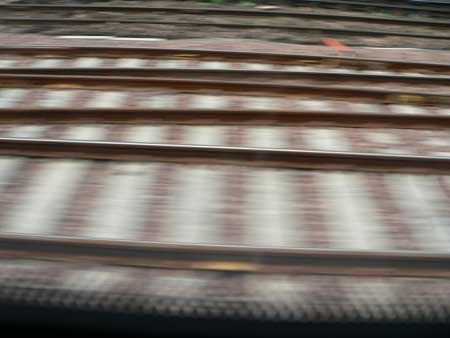
Tracks from a railroad car.
20 Lesley Chamberlain writes: "Wagner spoke of music conducting Nietzsche, and Nietzsche concurred" (63). The question to ask, then, for both Nietzsche and Thoreau, is what sound could make someone possible; help him jump the tracks of convention; conduct himself to himself? Conversely, for a sound to be "needed as medicine" (Nietzsche's phrase for his early dependence on Wagner), what sort of life is one conducting? (53). You and I, however, might employ Thoreau's sound writing much as he employed the woods of Walden: not so much to discover or to recover our identities (though shouldn't knowing ourselves always be a goal of education?), but as a "relay" (or heuristic) for imaging place in electracy. (Thoreau was imaging place in electracy? Not quite. But more on that topic shortly.) As Cavell observes, in what is perhaps his defining insight, Walden is particularly suited to tutor us as writers:
It is hard to keep in mind that the hero of this book is its writer. I do not mean that it is about Henry David Thoreau, a writer, who lies buried in Concord, Massachusetts—though that is true enough. I mean that the "I" of the book declares himself to be a writer. This is hard to keep in mind because we seem to be shown this hero doing everything under the sun but, except very infrequently, writing. It takes a while to recognize that each of his actions is the act of a writer, that every word in which he identifies himself or describes his work and his world is the identification and description of what he understands his literary enterprise to require. (5)
Cavell's admission "it takes a while" is an understatement; more like a lifetime in my case, however well spent. And so, here is a more manageable short-term assignment, a possible end-of-term experiment, contributing to the larger project of electracy:
Using Thoreau's sound writing as your tutor text (meaning, it holds your answer like a pond holds fish), identify and describe what the electrate task of imaging place might require. Next, create a multimedia text—video, podcast, webpage, Second-Life real estate—that meets the requirements you have identified.
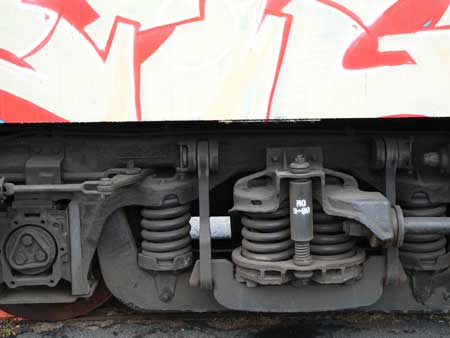
Graffiti on a railroad car in York, Pennsylvania.
21 Why is Thoreau useful as a relay for inventing electracy? As an invention, print was 350 years old when Walden was published in 1854. But as a medium, part of an apparatus (affordable books, libraries and newspapers) fostering democracy and the dream of universal literacy, it was new, its possibilities scarcely realized. My argument might appear counterintuitive: Walden anticipates or it imagines literacy yielding to electracy. Thoreau is not so much a latecomer to literacy, writing a book about its own writing, as he is an early avatar of electracy, electracy as a consequence—"a mutation or reformation"—of literacy (Ulmer 4). He uses old content in a medium only recently available to his social class and, subsequently, imagines even newer media. "The content of the new media," writes Ulmer recalling Marshall McLuhan's observation, "is the old media" (4). Synthesizing extant approaches to nature, Thoreau "created a way of seeing the world that is highly unusual for its era." Robert Richardson, in his biography of Thoreau, writes:
Thoreau revives the ancient Greek religious tradition, as Vincent Scully describes it, "in which the land was not a picture but a true force which physically embodied the powers that ruled the world." Ordinarily, one must agree with Scully that "it is only when the gods finally begin to die completely out of the land and when many human beings begin to live totally divorced from nature—at the beginning, that is, of the modern age—that landscape painting, picturesque architecture, and landscape description. . .become the obsessive themes of art," and the Greek view of the earth dies out. It is one of Thoreau's greatest accomplishments in Walden that both of these views are simultaneously put forward. One reason Thoreau's view of nature remains so attractive is that it sees nature as force, energy, and process, and as landscape, view, scene, or picture. (265-266)
I am not suggesting that Walden is somehow really an electrate text. I am, again, arguing against "impact narratives" that picture electronic technologies magically materializing—like the monolith in Kubrick's 2001—and transforming culture. In Thoreau's writing on sound, we witness an urge to electracy: meaning, we find traces of wishes; we find moods becoming practices taking technological forms (Sterne 27).
22 In order to take up Thoreau on the railroad and to identify and describe what the electrate task of imaging place might require, we ought to know something about the railroad's proximity to Walden Pond.
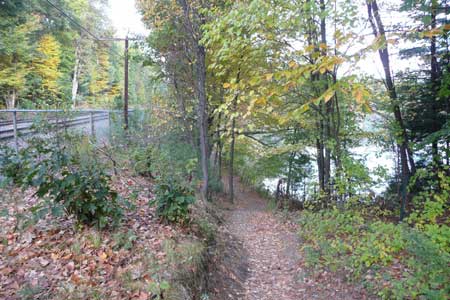
Railroad (left) and Walden Pond (right).
23 Even today, the Fitchburg Railroad runs right beside Walden Pond. In 1845, the year Thoreau built a cabin and began his experiment, the railroad was even more visible and audible than it is today. "That devilish Iron Horse," writes Thoreau, "whose ear-rending neigh is heard throughout the town…has browsed off all the woods on Walden shore" (125). As Richardson notes, Walden "was anything but peaceful. The new railroad line passed so close to the pond that an arm of it had to be filled in for the high and still quite visible embankment on which the rails were laid. One could see the new railroad from almost any point on the pond" (139). "[I]t touches the pond about a hundred rods south of where I dwell," wrote Thoreau. "I usually go to the village along its causeway, and am, as it were related to society by this link" (75). Thoreau seems amused that "the men on the freight trains" took him "for an employee." For, in a manner of speaking, he was. "I too would fain be a track-repairer somewhere in the orbit of the earth," he states, poetically expressing his vision of writing as a vocation. Walden's aim is to mend a little track. "Concord and Walden," writes Richardson, "were thenceforth much more closely tied, and obviously closely tied to the outside world.… [O]ut at Walden one might hear across the surface of the pond the sounds of the New World of industrial capitalism, first shovels, then hammers, then steam engines" (139).
24 It is unlikely that Hawthorne would have found Walden a spot suitable for poetic reveries. Thoreau, however, could sit in his "sunny doorway from sunrise till noon, rapt in a reverie…in undisturbed solitude and stillness" (72). "I am refreshed and expanded," he writes, "when the freight train rattles past me" (78). His key note—not the train sound but the mood it supports—is analogous to Ulmer's "image of wide-scope" and to Heidegger's "Stimmung," the enabling ground of feeling. To Thoreau, the railroad's refrain is neither the interruption of a natural and enduring order, nor an expression of the technological sublime we find in Whitman's "Passage to India" and "To a Locomotive in Winter." It is, rather, part of "one articulation of Nature" (81). This is attunement ("philosophizing with a hammer"). And it gives rise to writing. "The idea," writes Cavell, "is roughly that moods must be taken as having at least as sound a role in advising us of reality as sense-experience has" (124). Think cinematically about Walden (or note that Walden prompts us to think cinematographically and phonographically). In pulling focus "away from the plot line to the atmosphere or mood of the setting," Ulmer writes, "we are locating the place of transformation, of transition from literacy to electracy" (210). "The whistle of the locomotive penetrates my woods summer and winter, sounding like the scream of a hawk sailing over some farmer's yard," writes Thoreau (75). He is decidedly not a philosophus gloriosus lost in the woods, blissful and detached from experience. Again, of the railroad he writes, "I will not have my eyes put out and my ears spoiled by its smoke and steam and hissing" (80). And finally:
As I sit at my window this summer afternoon, hawks are circling about my clearing; the tantivy of wild pigeons, flying by twos and threes athwart my view, or perching restless on the white-pine boughs behind my house, gives a voice to the air; a fishhawk dimples the glassy surface of the pond and brings up a fish; a mink steals out of the marsh before my door and seizes a frog by the shore; the sedge is bending under the weight of the reed-birds flitting hither and thither; and for the last half hour I have heard the rattle of railroad cars, now dying away and then reviving like the beat of a partridge, conveying travelers from Boston to the country. (74-75)
Over a wheels-of-steel groove that Dopplers a sonic field, dropping in and out, plays a montage of sounds. In a word, Thoreau listens to—he improvises—a blues refrain. We might regard him as a bluesman bedeviled, framing problems in terms of mood. Or we might adopt "stuplimity," Ngai's neologism (worthy of George Clinton), to historicize, politicize and aestheticize the strangely ambivalent amalgamation of awe and tedium that characterizes Thoreau's emotional response to the railroad refrain (2). Richardson describes Thoreau as synthesizing "conceptions of nature as force, energy, and process, and as landscape, view, scene, or picture" (266). I rely again on Ulmer and suggest that "we are locating the place of transformation, of transition from literacy to electracy."
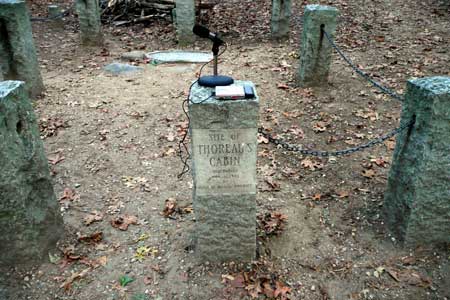
Site of Thoreau's cabin miked for sound.
25 We note it in this cited passage, but also, across the whole of Walden. "Every society has liminal regions where rites of passage occur" (Ulmer 216). Walden Pond is one such, national, spot. Here Thoreau's orientation to sound finds him hearing place as a combination of the choragraphic and the auralesque.
26 What do I mean? Because the auralesque is an easier concept to grasp, I will take it up first. It adapts the aesthetic category of "picturesque" for sound. As an aesthetic category, the picturesque was explained and popularized by the Reverend William Gilpin (1724-1804), a well-known English travel writer. (At this point, in a digital version of this essay, hyperlinks would proliferate, conducting readers to relevant literature on Wordsworth's "Tintern Abbey," the Claude Glass and black mirrors, Frederick Law Olmsted and the Hudson River school of landscape painting.) According to Richardson, Thoreau discovered Gilpin's books in April, 1852. From that date until the publication of Walden in 1854, Thoreau "read and studied everything he could find of Gilpin's.… Gilpin showed Thoreau the grand and integrative language of landscape" (Richardson, 260). The picturesque "is, literally, that which can be converted into a picture" (Maillet, 138). Thoreau performs the aural equivalent of this activity. He does not hear nature bare, nature in its putatively natural state. (That, I would argue, following Derrida, is not possible.) He listens, and "listening is a directed, learned activity: it is a definite cultural practice" (Sterne 19). Gilpin and perhaps, even Thoreau, would not agree.
In developing a theory of the picturesque, Gilpin established a distinction, at the beginning of his Three Essays, "between such objects as are beautiful, and such as are picturesque—between those, which please the eye in their natural state; and those, which please through some quality, capable of being illustrated by painting." (Maillet 138)
Gilpin gave Thoreau a vocabulary for "certain effects and appearances, and by describing them, he made them visible, in the sense that one often sees only what one has been prepared to expect" (Richardson, 264). In other words, Gilpin taught Thoreau a technique for seeing. I am arguing that he used an analogous technique for listening. Scully writes:
"[I]t is only when the gods finally begin to die completely out of the land and when many human beings begin to live totally divorced from nature—at the beginning, that is, of the modern age—that landscape painting, picturesque architecture, and landscape description. . .become the obsessive themes of art," and the Greek view of the earth dies out. (qtd. in Richardson, 265-266)
Agreed. But the roots of this orientation to place take us back to Aristotle. The picturesque and the auralesque derive from a conceptualization of place as topos.
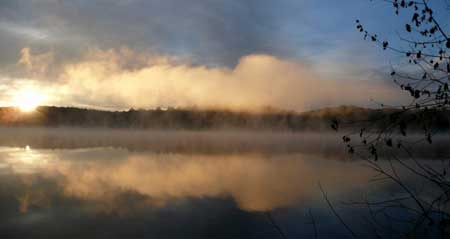
Panorama of Walden Pond on a fall morning, 2007.
27 Choragraphy takes us back to Plato's Timaeus. As a metaphor, chora refers to what happens on the threshing floor. There, through the motions of winnowing, a kind of elemental sorting takes place. Grain is separated from chaff. To the extent that I am capable of glimpsing chora as an idea (living, as I do and as Heidegger put it, in "the age of the world picture"), it refers to a place before place. Here—and "here" is already the wrong word—order is sifted from chaos, or better, chora separates place (topos) from non-place (kenon). It is force or energy. ("[I]n Plato's cosmology chora sorted chaos into the fundamental categories of earth, air, fire, and water"—Ulmer 101). Another image for chora was musical—"the tuning of a lute"—and that brings us back to the concept of attunement (to Pythagoras and Heidegger). "Chora," writes Ulmer, "names the sacred nature of specific places." It therefore "appears in the world as a literal place, a site and setting that manifests the 'cosmology' or ordering operations of a society" (211). That is precisely how Thoreau listens to Walden in the scene cited above. As a sacred grove, Walden gathers, holds and sorts "heterogeneous information in place by means of a shared mood or atmosphere" (101). This, then, is how Thoreau hears the writer's task: combine the auralesque (nature as landscape) and choragraphy (nature as force or energy) to image place. Make a world that is habitable.
28 In order to give readers a digital text, one responding to Thoreau's requirements for imaging place, I offer a remix of Drive By, a recording by the Necks, an Australian jazz-minimalist trio (keyboards, bass, and drums). Elemental stuff on my part, this remix—a mash-up really—relies heavily on a field recording I made, while in British Columbia, riding Vancouver's SkyTrain. I hear the pleasant hum of "the world's longest automated light rapid transit system" as a giant Buddha Machine, recalling a claim made by one of the members of Kraftwerk. He said, "As soon as you travel in a train, you're in a musical instrument" (qtd. by Kodwo Eshun in Lee). Download a low bit-rate version of the 60-minute track at my website.
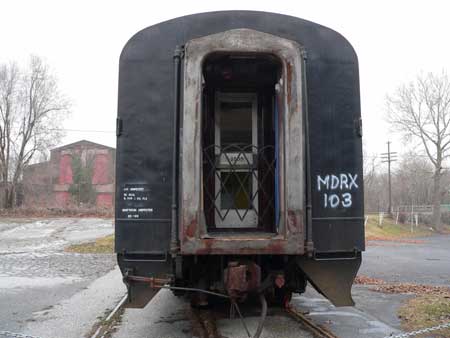
End of the line.
Works Cited
Augé, Marc. Non-Places: Introduction to an Anthropology of Supermodernity. Trans. John Howe. New York: Verso, 1995.
Cavell, Stanley. The Senses of Walden. Chicago: U of Chicago P, 1981.
Chamberlain, Lesley. Nietzsche in Turin: An Intimate Biography. New York: Picador, 1996.
Dervaux, Isabelle. Manet, Monet, and the Gare Saint-Lazare. Washington, D.C.: National Gallery of Art, 1998.
Kasson, John F. Civilizing the Machine: Technology and Republican Values in America, 1776-1900. New York: Hill and Wang, 1976.
Lee, Iara (director). Modulations: Cinema for the Ear. New York: Caipirinha Productions, 1998.
Lévi-Strauss, Claude. The Raw and the Cooked: Introduction to a Science of Mythology: I. Trans. John Weightman and Doreen Weightman. Chicago: U of Chicago P, 1969.
Maillet, Arnaud. The Claude Glass: Use and Meaning of the Black Mirror in Western Art. Trans. Jeff Fort. New York: Zone, 2004.
Marx, Leo. The Machine in the Garden: Technology and the Pastoral Ideal in America. New York: Oxford UP, 1964, 2000.
Ngai, Sianne. Ugly Feelings. Cambridge: Harvard UP, 2005.
Paul, Sherman. The Shores of America: Thoreau's Inward Exploration. Urbana: U of Illinois P, 1972.
Paulson, William. The Noise of Culture: Literary Texts in a World of Information. Ithaca: Cornell UP, 1988.
Sterne, Jonathan. The Audible Past: Cultural Origins of Sound Reproduction. Durham: Duke UP, 2003.
Robert D. Richardson Jr. Henry Thoreau: A Life of the Mind. Berkeley: U of California P, 1986.
Thoreau, Henry David. Walden; Or, Life in the Woods. New York: Dover Thrift Editions, 1995.
Ulmer, Gregory L. Internet Invention: From Literacy to Electracy. New York: Longman, 2003.
Weidenbaum, Marc. Personal communication. September 23, 2007.